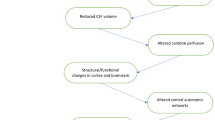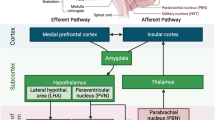Abstract
Central angiotensin II (AngII) plays an important role in the regulation of the sympathetic nervous system. The underlining molecular mechanisms are largely unknown. Spinophilin (SPL) is a regulator of G protein-coupled receptor signaling. Deletion of SPL induces sympathetically mediated arterial hypertension in mice. We tested the hypothesis that SPL restrains blood pressure (BP) by regulating AngII activity. We equipped SPL−/− and SPL+/+ mice with telemetric devices and applied AngII (1.0 mg kg−1 day−1, minipumps) or the AngII subtype 1 receptor (AT1-R) blocker valsartan (50 mg kg−1 day−1, gavage). We assessed autonomic nervous system activity through intraperitoneal application of trimethaphan, metoprolol, and atropine. We also tested the effect of intracerebroventricular (icv) AngII on blood pressure in SPL−/− and in SPL+/+ mice. Chronic infusion of AngII upregulates SPL expression in the hypothalamus of SPL+/+ mice. Compared with SPL+/+ mice, SPL−/− mice showed a greater increase in daytime BP with AngII (19.2 ± 0.8 vs. 13.5 ± 1.6 mmHg, p < 0.05). SPL−/− showed a greater depressor response to valsartan. BP and heart rate decreased more with trimethaphan and metoprolol in AngII-treated SPL−/− than in AngII-treated SPL+/+ mice. SPL−/− mice responded more to icv AngII. Furthermore, brainstem AT1-R and AngII type 2 receptor (AT2-R) expression was reduced in SPL−/− mice. AngII treatment normalized AT1-R and AT2-R expression levels. In summary, our findings suggest that SPL restrains AngII-mediated sympathetic nervous system activation. SPL is a hitherto unrecognized molecule with regard to central blood pressure control and may pave the way to novel strategies for the treatment of hypertension.






Similar content being viewed by others
References
Li YF, Wang W, Mayhan WG, Patel KP (2006) Angiotensin-mediated increase in renal sympathetic nerve discharge within the PVN: role of nitric oxide. Am J Physiol Regul Integr Comp Physiol 290:R1035–R1043
Zucker IH, Wang W, Pliquett RU, Liu JL, Patel KP (2001) The regulation of sympathetic outflow in heart failure. The roles of angiotensin II, nitric oxide, and exercise training. Ann N Y Acad Sci 940:431–443
Zucker IH (2002) Brain angiotensin II: new insights into its role in sympathetic regulation. Circ Res 90:503–505
Rabbitts JA, Strom NA, Sawyer JR, Curry TB, Dietz NM, Roberts SK, Kingsley-Berg SM, Charkoudian N (2009) Influence of endogenous angiotensin II on control of sympathetic nerve activity in human dehydration. J Physiol 587:5441–5449
Allikmets K (2007) Aliskiren—an orally active renin inhibitor. Review of pharmacology, pharmacodynamics, kinetics, and clinical potential in the treatment of hypertension. Vasc Health Risk Manag 3:809–815
Atlas SA (2007) The renin-angiotensin aldosterone system: pathophysiological role and pharmacologic inhibition. J Manag Care Pharm 13:9–20
Abramow-Newerly M, Roy AA, Nunn C, Chidiac P (2006) RGS proteins have a signalling complex: interactions between RGS proteins and GPCRs, effectors, and auxiliary proteins. Cell Signal 18:579–591
Brady AE, Limbird LE (2002) G protein-coupled receptor interacting proteins: emerging roles in localization and signal transduction. Cell Signal 14:297–309
Gross V, Tank J, Obst M, Plehm R, Blumer KJ, Diedrich A, Jordan J, Luft FC (2005) Autonomic nervous system and blood pressure regulation in RGS2-deficient mice. Am J Physiol Regul Integr Comp Physiol 288:R1134–R1142
Hercule HC, Tank J, Plehm R, Wellner M, da Costa Goncalves AC, Gollasch M, Diedrich A, Jordan J, Luft FC, Gross V (2007) Regulator of G protein signalling 2 ameliorates angiotensin II-induced hypertension in mice. Exp Physiol 92:1014–1022
Heximer SP, Knutsen RH, Sun X, Kaltenbronn KM, Rhee MH, Peng N, Oliveira-dos-Santos A, Penninger JM, Muslin AJ, Steinberg TH et al (2003) Hypertension and prolonged vasoconstrictor signaling in RGS2-deficient mice. J Clin Invest 111:445–452
Obst M, Tank J, Plehm R, Blumer KJ, Diedrich A, Jordan J, Luft FC, Gross V (2006) NO-dependent blood pressure regulation in RGS2-deficient mice. Am J Physiol Regul Integr Comp Physiol 290:R1012–R1019
Tang KM, Wang GR, Lu P, Karas RH, Aronovitz M, Heximer SP, Kaltenbronn KM, Blumer KJ, Siderovski DP, Zhu Y et al (2003) Regulator of G-protein signaling-2 mediates vascular smooth muscle relaxation and blood pressure. Nat Med 9:1506–1512
Wang X, Zeng W, Soyombo AA, Tang W, Ross EM, Barnes AP, Milgram SL, Penninger JM, Allen PB, Greengard P et al (2005) Spinophilin regulates Ca2+ signalling by binding the N-terminal domain of RGS2 and the third intracellular loop of G-protein-coupled receptors. Nat Cell Biol 7:405–411
Wang Q, Zhao J, Brady AE, Feng J, Allen PB, Lefkowitz RJ, Greengard P, Limbird LE (2004) Spinophilin blocks arrestin actions in vitro and in vivo at G protein-coupled receptors. Science 304:1940–1944
Richman JG, Brady AE, Wang Q, Hensel JL, Colbran RJ, Limbird LE (2001) Agonist-regulated Interaction between alpha2-adrenergic receptors and spinophilin. J Biol Chem 276:15003–15008
Smith FD, Oxford GS, Milgram SL (1999) Association of the D2 dopamine receptor third cytoplasmic loop with spinophilin, a protein phosphatase-1-interacting protein. J Biol Chem 274:19894–19900
Bernstein LS, Ramineni S, Hague C, Cladman W, Chidiac P, Levey AI, Hepler JR (2004) RGS2 binds directly and selectively to the M1 muscarinic acetylcholine receptor third intracellular loop to modulate Gq/11alpha signaling. J Biol Chem 279:21248–21256
Kimura T, Allen PB, Nairn AC, Caplan MJ (2007) Arrestins and spinophilin competitively regulate Na+, K+-ATPase trafficking through association with a large cytoplasmic loop of the Na+, K+-ATPase. Mol Biol Cell 18:4508–4518
Wang Q, Limbird LE (2002) Regulated interactions of the alpha 2A adrenergic receptor with spinophilin, 14-3-3zeta, and arrestin 3. J Biol Chem 277:50589–50596
da Costa-Goncalves AC, Tank J, Plehm R, Diedrich A, Todiras M, Gollasch M, Heuser A, Wellner M, Bader M, Jordan J et al (2008) Role of the multidomain protein spinophilin in blood pressure and cardiac function regulation. Hypertension 52:702–707
Feng J, Yan Z, Ferreira A, Tomizawa K, Liauw JA, Zhuo M, Allen PB, Ouimet CC, Greengard P (2000) Spinophilin regulates the formation and function of dendritic spines. Proc Natl Acad Sci USA 97:9287–9292
Liu YH, Xu J, Yang XP, Yang F, Shesely E, Carretero OA (2002) Effect of ACE inhibitors and angiotensin II type 1 receptor antagonists on endothelial NO synthase knockout mice with heart failure. Hypertension 39:375–381
Miller BH, Olson SL, Levine JE, Turek FW, Horton TH, Takahashi JS (2006) Vasopressin regulation of the proestrous luteinizing hormone surge in wild-type and Clock mutant mice. Biol Reprod 75:778–784
Janke J, Engeli S, Gorzelniak K, Sharma AM (2001) Extraction of total RNA from adipocytes. Horm Metab Res 33:213–215
Ferguson AV, Washburn DL, Latchford KJ (2001) Hormonal and neurotransmitter roles for angiotensin in the regulation of central autonomic function. Exp Biol Med (Maywood) 226:85–96
Matsumura Y, Hasser EM, Bishop VS (1989) Central effect of angiotensin II on baroreflex regulation in conscious rabbits. Am J Physiol 256:R694–R700
Pawlak R, Napiorkowska-Pawlak D, Takada Y, Urano T, Nagai N, Ihara H, Takada A (2001) The differential effect of angiotensin II and angiotensin 1–7 on norepinephrine, epinephrine, and dopamine concentrations in rat hypothalamus: the involvement of angiotensin receptors. Brain Res Bull 54:689–694
Head GA, Williams NS (1992) Hemodynamic effects of central angiotensin I, II, and III in conscious rabbits. Am J Physiol 263:R845–R851
Saigusa T, Iriki M, Arita J (1996) Brain angiotensin II tonically modulates sympathetic baroreflex in rabbit ventrolateral medulla. Am J Physiol 271:H1015–H1021
Lazartigues E, Lawrence AJ, Lamb FS, Davisson RL (2004) Renovascular hypertension in mice with brain-selective overexpression of AT1a receptors is buffered by increased nitric oxide production in the periphery. Circ Res 95:523–531
Samson WK, Bagley SL, Ferguson AV, White MM (2007) Hypocretin/orexin type 1 receptor in brain: role in cardiovascular control and the neuroendocrine response to immobilization stress. Am J Physiol Regul Integr Comp Physiol 292:R382–R387
Fontes MA, Xavier CH, de Menezes RC, Dimicco JA (2011) The dorsomedial hypothalamus and the central pathways involved in the cardiovascular response to emotional stress. Neuroscience 184:64–74
Iida N (1995) Different flow regulation mechanisms between celiac and mesenteric vascular beds in conscious rats. Hypertension 25:260–265
Allen PB, Ouimet CC, Greengard P (1997) Spinophilin, a novel protein phosphatase 1 binding protein localized to dendritic spines. Proc Natl Acad Sci 94:9956–9961
Tank J, Obst M, Diedrich A, Brychta RJ, Blumer KJ, Heusser K, Jordan J, Luft FC, Gross V (2007) Sympathetic nerve traffic and circulating norepinephrine levels in RGS2-deficient mice. Auton Neurosci 136:52–57
Milligan G (2003) Constitutive activity and inverse agonists of G protein-coupled receptors: a current perspective. Mol Pharmacol 64:1271–1276
Dampney RA, Coleman MJ, Fontes MA, Hirooka Y, Horiuchi J, Li YW, Polson JW, Potts PD, Tagawa T (2002) Central mechanisms underlying short- and long-term regulation of the cardiovascular system. Clin Exp Pharmacol Physiol 29:261–268
Mitra AK, Gao L, Zucker IH (2010) Angiotensin II-induced upregulation of AT(1) receptor expression: sequential activation of NF-kappaB and Elk-1 in neurons. Am J Physiol Cell Physiol 299:C561–C569
Nunes FC, Braga VA (2011) Chronic angiotensin II infusion modulates angiotensin II type I receptor expression in the subfornical organ and the rostral ventrolateral medulla in hypertensive rats. J Renin Angiotensin Aldosterone Syst (in press)
Saavedra JM, Benicky J, Zhou J (2006) Angiotensin II: multitasking in the brain. J Hypertens 24:S131–S137
Acknowledgments
We thank Ilona Kamer, Lisa Zocher, and Yoland Marie Anistan (Max Delbrück Center for Molecular Medicine, Berlin, Germany; Experimental and Clinical Research Center, Medical Faculty of the Charité) for technical assistance. EK (KL1415/4-2) and MK (GO766/12-1, GO766/15-1) were supported by DFG. The authors are not aware of interest conflicts.
Sponsorship
The Deutsche Forschungsgemeinschaft supported VG (Gr 1112/13-1) and ACCG (Kl1415/3-2). MAPF was supported by CNPq/CAPES-Probral, Brazil.
Author information
Authors and Affiliations
Corresponding author
Rights and permissions
About this article
Cite this article
da Costa Goncalves, A.C., Fontes, M.A.P., Klussmann, E. et al. Spinophilin regulates central angiotensin II-mediated effect on blood pressure. J Mol Med 89, 1219–1229 (2011). https://doi.org/10.1007/s00109-011-0793-8
Received:
Revised:
Accepted:
Published:
Issue Date:
DOI: https://doi.org/10.1007/s00109-011-0793-8




